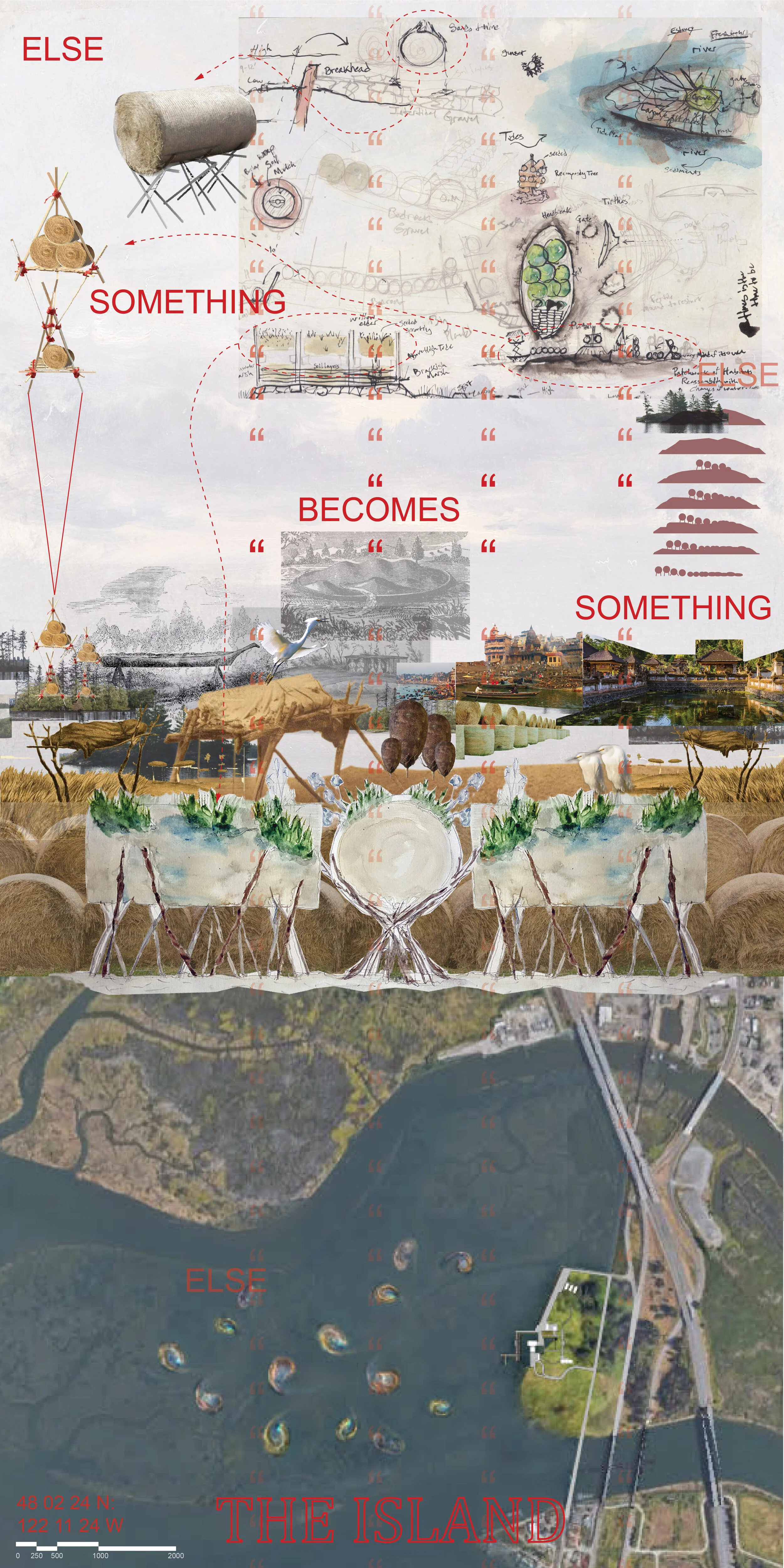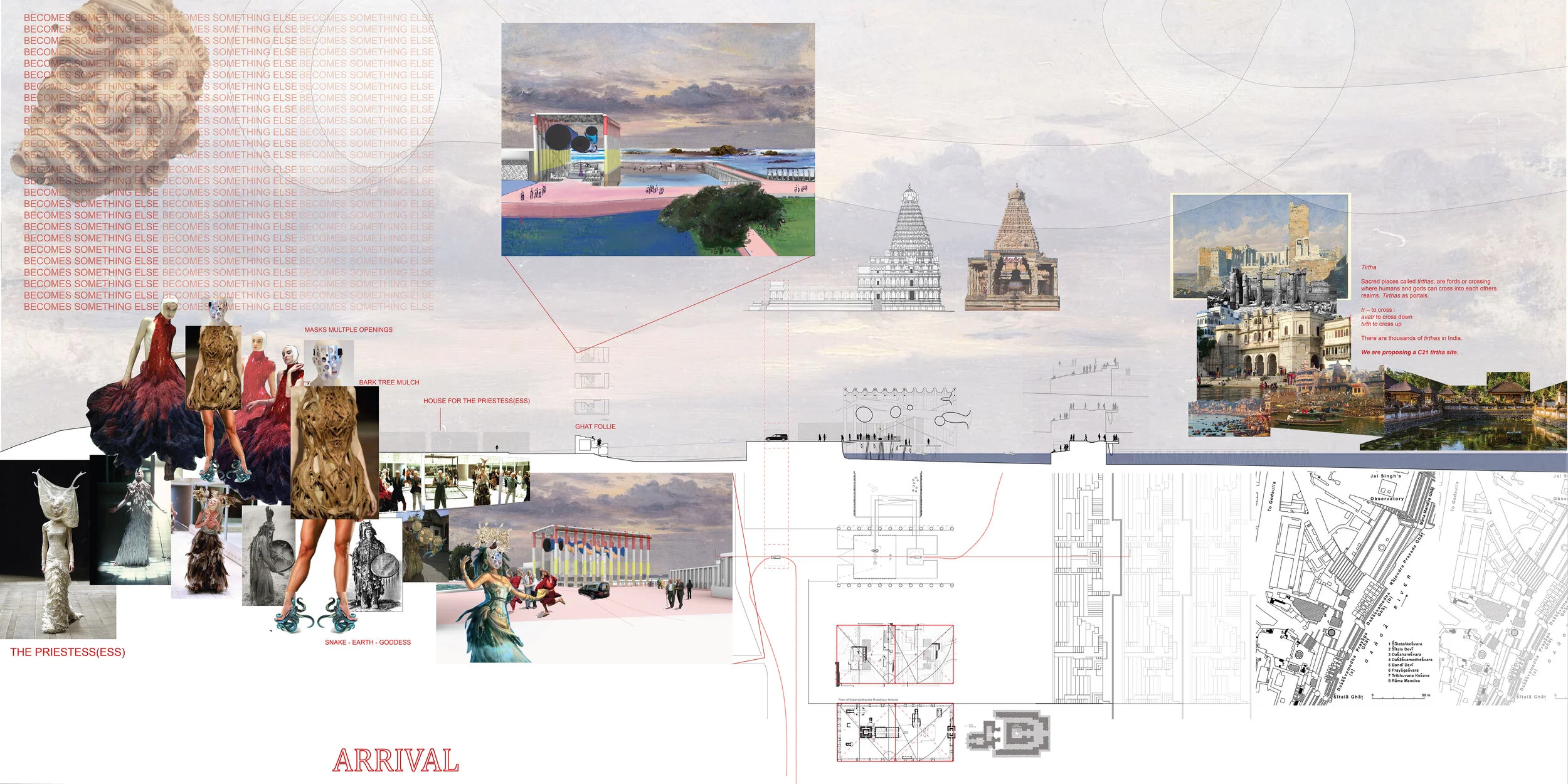
Tirtha:
Recomposting Temple Complex
Exhibited in Time Space Existence, Venice, Palazzo Bembo, 2021
This Recomposting Temple Complex is where human bodies can not only be composted, but also where bodies can be ceremonially received, prepared, and honorifically "sent off" to the recomposting islands just off-shore from the temple. The originating conceit of the project is that while the science of human body recomposting is well developed, we don't yet have a cognizant and matching 21st century social epistemology for recomposting, that can be celebrated with an appropriate honorific ritual practice, which of course needs to be staged upon a suitably rich, ritual architecture. OUR project aspires to do just that, joining the work of others in this field.
Scroll left-right

Tirtha: An Architectural Opera
Exhibition mockup for Time Space Existence, Venice 2021
The Epistemology
The basic epistemic conceit of the project is "....something becomes something else....". The laws of physics suggest, indeed require, that everything in the universe, 'dead' or 'alive' is made of the same sub-atomic particles and forces and is subject to all the same laws, without exception. This suggests therefore that birth and death, while indisputably significant 'events' in this complex sub-atomic particle configuration we call life, are in fact little more, and nothing less, than reconfigurations of sub-atomic particles and forces, a process that is enacted in the universe in a myriad different ways, everywhere. Life on planet earth is no doubt a very special event; even so, it is part of the infinite diversity of particularly re-configuration - "...something becomes something else..." again and again, that is fundamental to the processes of the universe.
Tirtha is a Sanskrit word that means "crossing place, ford." In India, there are dozens of these places, some of which have become pilgrimage sites. In this project the temple is at the core of the tirtha, but ‘the crossing’ is a drawn-out spatial and temporal process that encompasses the whole site and its program. In that sense the tirtha is embedded in a type of ‘temenos’ or sacred area, the intensity of which is thickened over time and use.
Research: Shades, Shadows, Haunts
Eschewing the traditional modernist pretension that purports to derive form from “fundamentals,”, OUR designs by entangling ourselves into the perennial river/rain of architectural, intellectual, symbolic and formal “references” (need better word).
Our research unearthed that Native American, Mongolian, Zoroastrian and in an indirect way Hindu funerary practices already intuit this epistemology. OUR approached the design through a robust exchange of ideas that incorporated ‘Shades, Shadows, Haunts’ - as opposed to the more conventional idea of ‘program’ or ‘precedents’. These various Shades, Shadows, Haunts emerged in the conversation and in the design process and are based on the two author’s various past experiences and influences. A Shade was seen as an influence with a neutral valence, a Shadow was something more pressing whereas a Haunt was something perhaps darker and more difficult to ‘explain’ in any rational way. We associated Haunts with the psychosomatic imponderables associated with our biographies. For Prakash, for example, Le Corbusier was a haunt, for Jarzombek, it was the ‘factory.’ Both of us recently experienced the death of our fathers and that too factored into the background of the conversation.
The Core: Ecological Recomposting Island.
Building on this basic, inflexible science, we have imagined the 'core' of the project in the form of an island in making, where human bodies, 'cocooned' in organic pods with carefully calculated amounts of mulch, oxidizers, catalysts....and such, are left to compost in the open air, eventually off-gassing and disintegrating and falling to the ground. As bodies become soil, they will build up the island, which will then also of course be eroded by the tides and the movements of the water, maintaining balance. The ecology of the island in this way reiterates and joins in with the reconfiguring ecology of the cocoons. Each body is expected to take 3-6 months to recompose into soil and gas.
Organized in tiers to promote 'hill' formation, the island is intended to be minimally serviced, operating via natural processes, with (possibly self-running, like Wall-e) fork lift kind of a mechanism to receive and deposit bodies on simple pyramidical 'stands'. Here we derive our inspiration in particular from the canoes that were used by coastal native peoples of the PNW to leave their bodies to compost in the cedar forests.
The Cocooning Shed.
All bodies have to be ‘prepared’ for composting, which is to say they have to be ‘cocooned’ within a carefully calibrated mixture packed with a consistency that is able to support both decomposition and aeration. We call this preparing the ‘cocoon’, a symmetrical metaphor to the life transforming cocoon of the caterpillar. The cocoon can also be thought of as a ‘Death-Womb’, if the maternal womb is to be thought of as a ‘Life-Womb’.
To support the Cocooning function, we have designed on shore a simple, functionalist shed, a cordoned off production facility where the cocooning technicians can work undisturbed efficiently and precisely. This Shed is of course supported via a loading dock, and a parking and delivery area, with its own independent truck accessible road.
The Weighing Temple.
The Weighing Temple is the pivot and the center of the entire Recomposting Complex. At the certain point the family and friends of the deceased will have to hand over the body to the recomposing facility. This is, from the ‘secular’ point of view, the ‘moment-of-truth’, an opportunity for a ritualistic acceptance and acknowledgement of the recompos(t)ed destiny, and origins, of all human life.
The geometric order of the Weighing Temple is defined by two interlocked sets of shifted double squares. These interlocked double-squares - implied even at the still larger scale of the site plan - are meant to signify the equivalence, and entangled interdependence, of the two main symbolic functions of the Temple, the Weighing and then the “sending off” - the Alvida, in Sanskrit - of the cocoon via a self-driving boat. These two symbolic parts of the Temple are supplemented by a Cocooning Shed, a cordoned off production facility that intermediates between the two symbolic sections.
To ‘receive’ the body from the family, we have designed a receiving temple whose focus is a large and magnificent balance designed to weigh the body, a measure that on the one hand necessary to calculate the amount of composting materials required for its cocooning, and on the other, it mirrors the weighing of the infant that is routinely done at birth. Conceptually speaking, from a recomposing perspective, the difference between the birth and death weight of a person can be thought of as the ‘progress’ made by that person. The body is measured against carefully delineated ingots of gold, and the difference in measure, between the birth and final weight of the person, is announced with due ceremony for all to hear by the Presiding Priestesses, the ‘death-doulas’. The Priestesses, who are both mistresses of ceremony and recomposing scientists, are dressed in ceremonial regalia that derives equally from the ‘savage-beauty’ aesthetic of Alexander McQueen, in particular his Voss show, and the ceremonial dresses of Native American shamans.
The Weighing Balance is protected by a cloth shroud, or is it a veil, that is ceremonially lifted just prior to its use. Balances are carefully calibrated, delicate and precise instruments and have to be carefully protected. All in all, the envelope of the Temple is developed from a partii based on pragmatics; it is a garage to house the weighing balance. The precious balance, after all, has to be protected from the elements.
The Columns of the temple are painted in red, white and yellow to evoke the dominant colorations of the corporeal body with all its blood, muscle, organs, bones, spleen and feces. The Temple does not seek to sublimate the body.
Mirrored across the temple, jutting into the planted landscape, is a paved walk with rest stops and a small reflecting pool, which could be developed into a bioswale.
The Horns.
Above the Balance, hanging from the roof of the Temple are a series of inter-twined wind-horns. Self-blowing (no one ‘plays’ them, though their access to wind can be turned on and off,) these horns are imagined as visual and acoustic totemic objects, fetishes in the ritualistic sense of the word, intended to sculpturally encapsulate the arbitrary uncertainties of life, the inexorable and perpetual turning of the ‘levers’ and ‘pumps’ of the universe - the quantum uncertainties, might be the technical term from particle physics - that are always at play, enveloping human life, simultaneously sustaining it and breaking it down by pushing it in the direction of ever higher entropy, the process we call aging. Their horizontality is designed to offset the usual verticality associated with death in monotheistic religions. Like all fetish objects of yore, the horns perform no literal function but are intended to embody the ‘magic’ of recomposition that is birth and death - “…..something becomes something else….”
The Boat, the Ghats, the Boardwalk and the Belvedere
After the body is received and cocooned at the temple, it is carefully lowered into a womb-like, self-running boat via a loading dock built into the ‘back’ of the temple, into one of the double-squares. In plan, this dock and its access passage reproduce the form of a garbh-griha, the ‘womb-home’ of a Hindu temple. As the boat enters and leaves the dock, it reproduces the movements into and out of the birthing canal.
As the boat emerges out of its loading dock and makes a left turn, it finds itself enveloped within a C-shaped marina, made out of boardwalks, a playful set of viewing steps or ghats, and a viewing platform, something like a belvedere. Together, the ghats, the boardwalk and the belvedere form an amphitheater for the friends and families of one cocooned in the boat, to view and bid a ‘final’ farewell. The marina in this way functions as a theatre, with the boat its evanescent stage.
The ghats are derived in form from the steps that line the edges of sacred rivers and sacred water tanks in Hindu India. They do not, however, function like ghats, in the sense that they are not intended for worshipping the water via ablution practices. They are simply a playful amphitheater. The steps make different configurations during high and low tides, marking the passage of time and our proximate connectedness to distant objects like the moon.
The belvedere is intended to enable those who are interested in it, access to the notion of ‘prospect’, the illusion that via higher elevation one can gain ‘better’ understanding. While this understanding offers nothing more to view, it is offered to those would like it, access to the haptic solace of vantage, an ancient body-memory passed down to us perhaps from our hunting-gathering (better term?) ancestors. In this sense, the ‘belvedere’ is also a folie.
On the outer side of the C-shaped marina, accessible only during low tide, a single boardwalk juts out towards the recomposting islands, offering a promenade architectural, a contemplative walking path.
Parking and the Arrival Plaza.
The transition into and the initial arrival at a solemn and sacred site, which is inevitably at a parking lot, has been designed to afford dignity worthy of that moment. When one parks the car and turns off the engine, that is when one has to switch one’s mind to ‘face’ the task at hand. It is a split second, but one that has the potential to linger in memory.
When the arriving vehicles reach the Temple Complex, one of which has to presumably be something equivalent to a hearse with the body, they will see little to nothing of the temple itself because it is shielded by a thickly planted berm. As they turn in and pass by the berm, it will feel like they are passing through semi-rugged, naturalistic landscape profusely planted and maintained with local species, including cedars (if possible). Ahead a view of Puget Sound.
Another turn to the left and the temple comes into view in the distance, seemingly perched on a framed by the water. A long line of cars and parking spots await on the right. At the end of the road is a arrival plaza, a kind of an open throat, where the tarmac ends and the ‘sacred’ temenos of the Temple complex, paved in red/pink sandstone begins. The hearse waits in the center of this Arrival Plaza, while the community parks and gathers around it. A stoa and other facilities mark the edges of the Plaza, offering relevant amenities to the gathered, like the markets that traditionally line the entrances of Hindu and Buddhist temples, and mosques, in many parts of the world.
From the Arrival Plaza, the hearse proceeds to the Temple on the sandstone path, and parks directly on axis with it, ready to deliver the body. The arrival is complete, and the ceremonies of the Temple are ready to begin.
The Beach
Along the entire 110 meters length of the parking there is an elevated pathway followed by steps, a simplified version of the ghats that envelope the Temple, leading to a sandy/rocky beach, typical of the PNW. Publicly accessible at all times, we imagine this as a recreational area, promoting a normalized engagement of the carnival of life with that of death.
The Fermenting Institute, the Residences
The vast planted grounds of the Complex are intended to be developed into a research and teaching laboratory on the sciences of fermentation and body composting. This includes ‘humanities’ and ‘design’ wings dedicated to developing discourses and ritual practices integrated with the science.
A workshop from where the temple can be maintained and residences with connected ‘robing’ rooms for their dresses are indicated on plan, and remain to be developed.
Opera-Architecture: The Recomposting of Roy Batty, Replicant 1(?)
We have 'presented' or better actualized our ‘conceptual’ project in the form of a filmic opera, organized around the funeral of a matching 'grand' personality. But the big idea is that in the form of the opera, the project comes alive - is completed. We are talking, in other words, of architecture as opera, opera-architecture! ……more to come.
Credits: OUR would like to thank Michelle Hook, Amelia Jarvinen, Jung In Seo, Dalma Foldesiand, and Elias Jarzombek for their contributions.




























